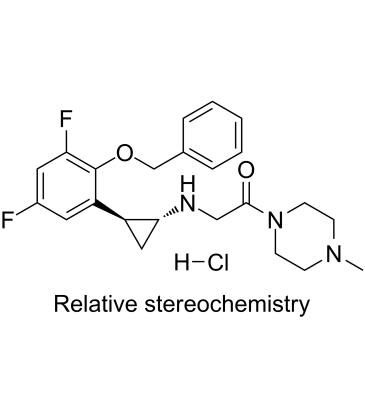| Description |
S2157, a N-alkylated tranylcypromine (TCP) derivative, is a potent lysine-specific demethylase 1 (LSD1) inhibitor. S2157 increases H3K9 methylation and reciprocal H3K27 deacetylation at super-enhancer regions. S2157 induces apoptosis in TCP-resistant T-cell acute lymphoblastic leukemia (T-ALL) cells by repressing transcription of the NOTCH3 and TAL1 genes. S2157 efficiently pass through the blood-brain barrier and can almost completely eradicate CNS leukemia in mice transplanted with T-ALL cells[1].
|
| Related Catalog |
|
| Target |
LSD1[1]
|
| In Vitro |
S2157 is particularly effective for T-ALL cell lines with the IC50 values between 1.1 µM for human T-ALL cell lines CEM and 6.8 µM for MOLT4[1]. S2157 (4-20 µM; 72 hours) modestly inhibits mitogen-activated normal T-lymphocytes[1]. S2157 (4-8 µM; 24 hours) induces apoptosis and down-regulates the expression of NOTCH3 and TAL1 proteins in T-cell acute lymphoblastic leukemia (T-ALL) cells[1]. Cell Viability Assay[1] Cell Line: Normal T-lymphocytes Concentration: 4, 8, 12, 16, 20 µM Incubation Time: For 72 hours Result: Modestly inhibited mitogen-activated normal T-lymphocytes. Apoptosis Analysis[1] Cell Line: T-cell acute lymphoblastic leukemia (T-ALL) cells Concentration: 4, 6, 8 µM Incubation Time: For 24 hours Result: Induced apoptosis, as evidenced by increased annexin-V reactivity on flow cytometry in T-ALL cells in a dose- and time-dependent manner without affecting cell cycle distribution. Western Blot Analysis[1] Cell Line: T-ALL cells Concentration: 4, 6, 8 µM Incubation Time: For 24 hours Result: Down-regulated the expression of NOTCH3 and TAL1 proteins in T-ALL cells.
|
| In Vivo |
S2157 (50 mg/kg; IP; 3 times a week; for 28 days) causes the size of subcutaneous tumors reduced to less than 20% of that in the untreated control[1]. S2157 (50 mg/kg; IP) has a T1/2 of 0.88 hours, a Cmax of 4.33 μM and an AUC of 5.75 μM•h[1]. S2157 (30 mg/kg or 50 mg/kg; twice a week for 3 weeks) almost completely suppressed the growth of MOLT4 cells in most but not all NOD/SCID mice with MOLT4 cells. S2157 eradicates CNS leukemia in murine xenotransplanted models[1]. Animal Model: Nonobese diabetic/severe combined immunodeficiency (NOD/SCID) mice with MOLT4 cells[1] Dosage: 50 mg/kg Administration: IP; 3 times a week; for 28 days Result: The size of subcutaneous tumors reduced to less than 20% of that in the untreated control. Animal Model: 8-week-old ICR mice[1] Dosage: 50 mg/kg (Pharmacokinetic Analysis) Administration: IP Result: Had a T1/2 of 0.88 hours, a Cmax of 4.33 μM and an AUC of 5.75 μM•h.
|
| References |
[1]. Shiori Saito, et al. Eradication of Central Nervous System Leukemia of T-Cell Origin With a Brain-Permeable LSD1 Inhibitor. Clin Cancer Res. 2019 Mar 1;25(5):1601-1611.
|
